Here are some tips on how to identify edible boletes when you are foraging mushrooms in Finland. There are 70-80 different boletes growing in Finland, plus hundreds of other types of mushrooms, so in this post we will only look at the most common boletes and learn some basic information about them. The boletes are good mushrooms for beginners because they are delicious, and they are not easily mixed with poisonous ones.
Kind reminder: If you are not 100% certain that you recognize the mushrooms you are picking and know how to prepare them, do not eat them. We take no responsibility for damage caused by wrong identification or preparations. If you are beginner with mushrooms, it is always best to ask someone to physically confirm your mushroom identifications. Some mushrooms change color when cut or they might have a recognizable smell, therefore identifications should not be based on pictures only.
The most common Genuses of edible boletes
Boletes can be identified by their sturdy stem, round cap, and pores under the cap. The main Genuses of edible boletes in Finland are as follows:
- Boletus
Boletus family contains delicious and some of the most valued mushrooms in Finland. The family includes delicacies such as penny bun (also known as porcini or cep), pine bolete and summer bolete. They are best identified by pores, a bulky stem, and a white net pattern on the stem underneath the cap. - Leccinum
There are boletes that have beautiful brown, light brown, or orange caps, but dark spots in their stem. They are Leccinum boletes, which are known to be delicious mushrooms to eat but slightly harder for the stomach to handle than the most valued Boletus family. Common features of the Leccinum family are dry topcoat of the cap, dark tufts of the stem, and grayish spore tubes underneath the cap. - Xerocomus
Most members of Xerocomus are edible but mediocre in gastronomical value and inferior to the highly sought-after porcini. A good common attribute for the Xerocomus is velvety fluffy cap. - Suillus
The Suillus boletes grow conifer forests next to pine trees and they are recognized by yellow, orange or olive-yellow pores and a slimy topcoat. Actually, they are commonly called “slippery jacks” because the cap is sometimes slimy.
Examples of different boletes in Finland
- Penny bun
- Pine bolete
- Summer bolete
- Birch bolete
- Orange birch bolete
- Mottled bolete
- Foxy bolete
- Bay bolete
- Suede bolete
- Variegated bolete
- Slippery jack
- Non-edible boletes
Penny bun (Boletus edulis)
Penny bun, or cep, is the most popular bolete known as herkkutatti in Finland. Herkku means delicious, and tatti describes the type of mushroom, bolete. The penny buns can usually be found from July to August in deciduous and coniferous forests. They can vary in color, the cap is deep brown or light brown, and the stem is beige or almost white. The stem is usually bulky from the root part. One important sign of the penny bun is that the stem has a white net pattern right underneath the cap. The pores of the penny bun are white at an early age, yellow in older specimens, and even green on old mushrooms. The pores can be eaten, but I usually remove them from older mushrooms. The penny bun has a faint but pleasant smell and a mild nutty taste. One reason it is considered as a safe mushroom to forage by a beginner is that none of its close lookalikes are poisonous. Penny buns are tasty when fried in butter, but they can also be frozen or dried for later use.
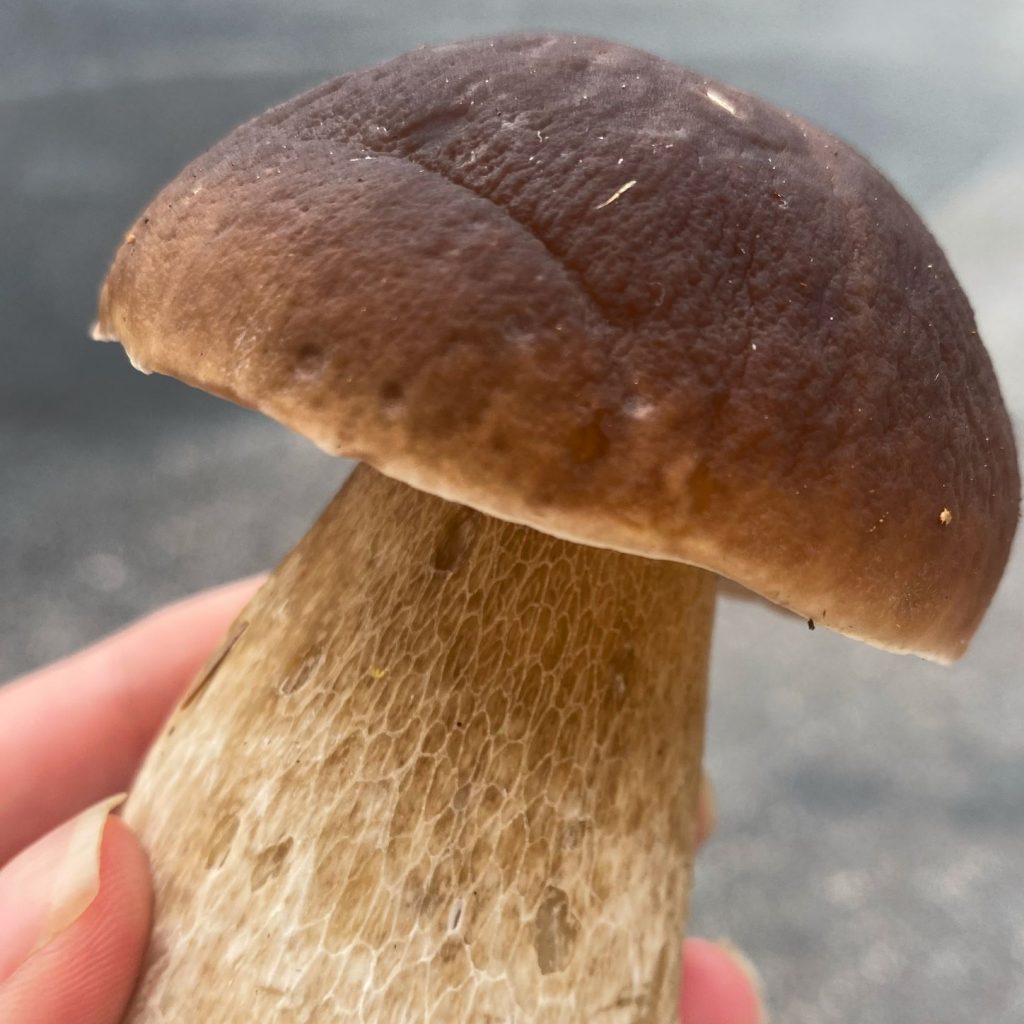
Pine bolete (Boletus pinophilus)
Pine bolete, männynherkkutatti, is remarkably like the penny bun, equally excellent mushroom to eat. It has a similar deep brown cap and light beige-colored stem with white net underneath the cap. It grows in pine forests throughout the entire country, except in Fell Lapland. I have learned that boletes are easier to find from areas where there isn’t a lot of vegetation on the ground. This means that they might pop up in the middle of a trail or forest road.
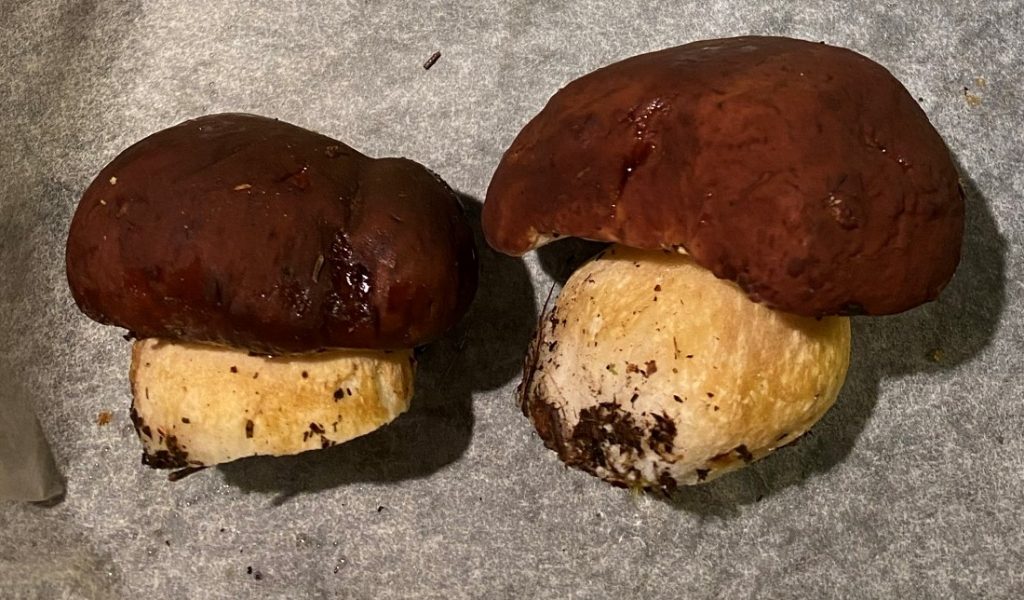
Summer bolete (Boletus reticulatus)
Here in Finland the summer bolete, tammenherkkutatti, grows at the same time as other boletes, from August to September, so it is not particularly early. It resembles the penny bun and pine bolete, and it is equally delicious mushroom to ear. The summer bolete can be found close to oak, beech, and hazel trees.
Birch bolete (Leccinum scabrum)
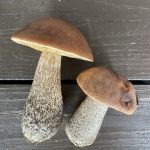
The birch boletes have light brown and usually dry caps. The easiest way to tell Leccinum boletes apart from Boletus is the stem. Leccinum boletes such as the birch boletes have thinner stems, which have dark spots. In older specimens, the pores on the pileus can bulge out because the cap doesn’t extend over the pores. The pores are white at an early age, later grey. You can tell the birch boletes apart from other Leccinum boletes from the cut – the birch boletes doesn’t change color. They are much less valued than penny buns, but they are edible and considered to be tasty. All Leccinum mushrooms should be cooked well, and they can be stored frozen or dried. In Finland, the birch bolete is commonly known as lehmäntatti, cow’s bolete.
White birch bolete, Leccinum holopus, is like the birch bolete but lighter in color like the name suggests. In Finnish it’s known as valkolehmäntatti, white cow’s bolete. It is also edible but not even as good as birch bolete. While the birch bolete does not change its color when cut, the white birch bolete does. It becomes blueish green. In fact, the whole mushroom becomes greenish when it grows older. But for safety reasons I wouldn’t recommend picking and eating any white mushrooms in Finland. Nor green.
Orange birch bolete (Leccinum versipelle)
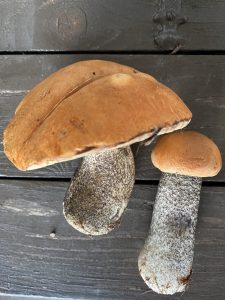
The orange birch bolete, koivunpunikkitatti, is easy to recognize due to its orange cap color. Its flesh turns purple or even black when it’s cut or touched. The orange birch bolete is tasty, but mildly toxic and should be fried for at least 15 minutes like all Leccinums. As the bolete changes color to dark when cooked, it is not the most appetizing mushroom to eat. Like other boletes, it can be dried or frozen for later use. The orange birch bolete grows near birch trees, and it is quite common throughout the country.
Leccinum aurantiacum, haavanpunikkitatti, red-capped scaber stalk, looks similar but grows next to aspen. It is also edible, and its flesh also turns dark when cooked. Same applies to Leccinum populinum, lehtopunikkitatti, which also grows near aspen in mixed forests.
Foxy bolete (Leccinum vulpinum)
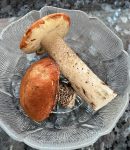
The edible foxy bolete has longer, white stem covered with dark tufts that are typical for the Leccinum. The cap is reddish brown, and it continues under the cap. This is an effective way to tell the foxy bolete apart from the birch bolete. The foxy bolete grows in association with pine trees and in Finland it is in fact known as männynpunikkitatti (mänty=pine). It is common especially in Lapland.
Mottled bolete (Leccinum variicolor)
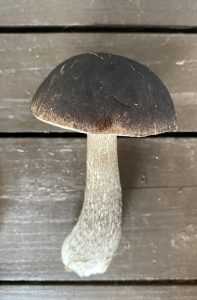
The mottled bolete, nokitatti, has different shades of grey caps and whiter stems. Variicolor in the mushroom’s Latin name is a reference to the very variable cap color. The stem flesh is white but sometimes turns pinkish in the upper section when it is cut, while near to the stem base the flesh turns blue when cut. Pores are white, but when bruised, the pores gradually turn brownish. Talking about variable colors!
The mottled bolete, like the birch bolete and orange birch bolete, prefers to grow next to birch trees all around the country. It must be cooked properly like all Leccinum mushrooms, and it can be stored frozen or dried. I think mottled boletes are much harder to find than orange boletes due to their darker color.
Bay bolete (Imleria badia)
Bay bolete, ruskotatti, is less known than penny bun but equally delicious. When processed, the brownish flesh turns blue for a while, but the color change does not affect the taste in any way. The bay bolete used to be classified as part of Xerocomus in the past, but it is not particularly closely related to species in that genus. The mushroom has a chestnut to deep brown cap with large cream pores that become yellow or olive with age.
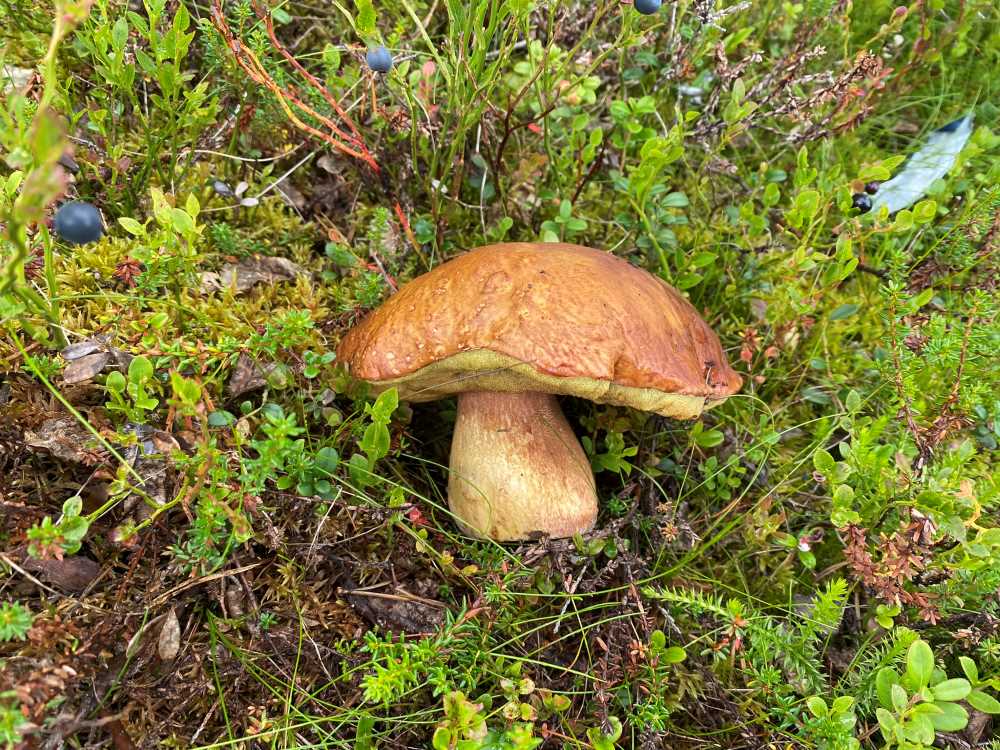
Suede bolete (Xerocomus subtomentosus)
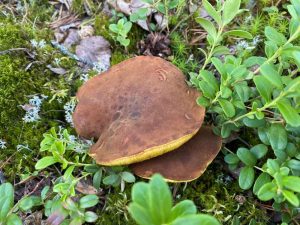
Suede bolete, samettitatti, is edible but not a very valued bolete. It can be used for dyes for orange and yellow colors. Subtomentosus is Latin “finely haired”, referring to its cap. The mushroom indeed looks like suede or velvet from the top. The pores underneath the cap are lemony yellow, also greenish in older specimens. The pores bruise blue when touched, and the mushroom smells very lightly fruity. The suede bolete can be found anywhere in Finland from lawns to birch forests in fells, and it accompanies many different hardwood and conifer trees. I found this by a nature trail in a spruce forest. The suede bolete used to be classified as Boletus, since 1753, but it is in fact Xerocomus. Genetic analysis published in 2013 confirmed the distinctness of this species and its close relatives from the core group of fungi in the genus Boletus.
Variegated bolete (Suillus variegatus)
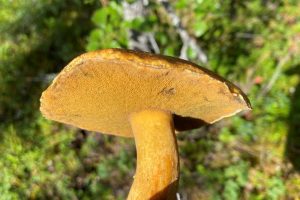
Variegated bolete is a species of edible mushroom in the genus Suillus. Also known as velvet bolete, kangastatti in Finnish, this is a yellowish-brown mushroom that from the top might look like someone dropped cinnamon on it. It can be mixed with peppery-tasting and unedible peppery bolete, äikätatti, Chalciporus piperatus. Variegated bolete has sturdier stem and smaller pores, and it lacks the peppery taste. The pores become blueish when touched. This mushroom can be found near pine trees in August or September. It’s common throughout the country, all the way to Lapland if there are pine trees. It can be stored frozen, and it can be used for dyeing as it is a natural source of the color yellow.
Slippery jack (Suillus luteus)
Slippery jack is another highly valued bolete in Finland. It is known as voitatti, butter bolete, here. It has a brown cap, yellow pores, and a white stem. It’s easy to recognize as unlike most other boletes, it bears a distinctive membranous ring that is tinged brown to violet on the underside. Small slippery jacks don’t have the ring yet as they drop from the top. Slippery jacks are best to be picked young as they easily get maggots. It is an excellent edible mushroom but can be difficult to clean. There is often debris stuck to the surface and the mushroom must be peeled before cooking. Removal of the surface film is easiest when the mushroom is first split from the base and then the halves are pulled away from the surface film. Drying and freezing are both suitable preservation methods for this mushroom. Dried to a crisp, the mushroom is versatile and can be stored for a long time. Suillus grevillei and Suillus granulatus resemble slippery jack but are both also tasty mushrooms.
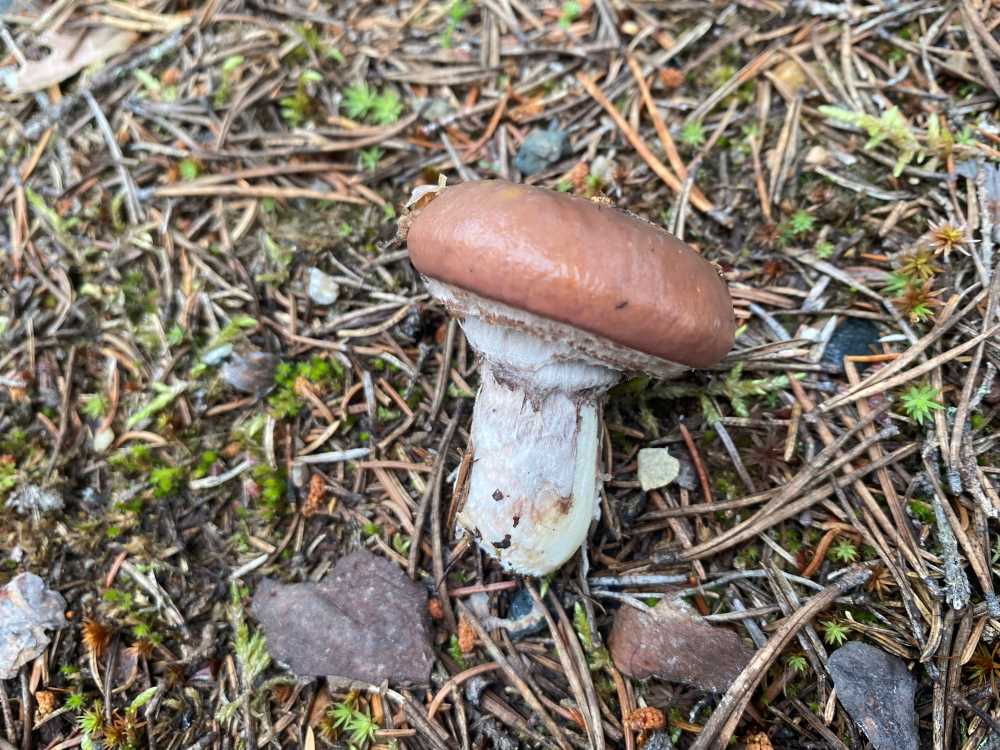
Non-edible boletes
The edible boletes introduced above should not be mixed with bitter bolete, sappitatti in Finnish, Tylopilus felleus, which is common in Finland. It is not poisonous, but it has a very bitter taste that ruins your food. Bitter bolete looks a bit like penny bun, but instead of white net pattern it has a dark pattern in its stem. Bitter bolete has reddish pores when it gets older, while the penny bun has yellow and greenish pores.
Another strong-tasting bolete is peppery bolete, äikätatti, Chalciporus piperatus, which is a slightly slimy, light brown bolete with same colored narrow stem. As a special characteristic, the peppery bolete’s stem can snap loudly when picked. It’s not recommended to be eaten due to its strong taste, but it could be used to replace pepper in cooking when dried.
Some much more rare and not edible boletes in Finland include lurid bolete, tauriontatti, Suillellus luridus, which is a red-pored bolete that stains blue when bruised or cut. It’s slightly toxic uncooked. Scarletina, veritatti, Neoboletus luridiformis, is another red-pored bolete, which is not poisonous but also not recommended to be eaten. Satan’s bolete, piruntatti, Rubroboletus satanas, is one poisonous bolete but it has been spotted in Finland only once, in 1943. I don’t think you will run into that.
Are you into mushroom foraging? Do you pick boletes? We would love to hear what your favorite bolete is.
Read more about mushrooms
- Mushroom picking in Finland is fun
- Foraging for the most common mushrooms in Finland
- What is the difference between true morels and false morels?
- Colorful brittlegills are a fascinating family of mushrooms
- Cep or bitter bolete? How to tell the difference
- How to dress and what you need for foraging berries or mushrooms
- How to tell chanterelle and false chanterelle apart
- How to identify different milkcaps in Finland
- Watch out for the deadliest mushrooms in Finland

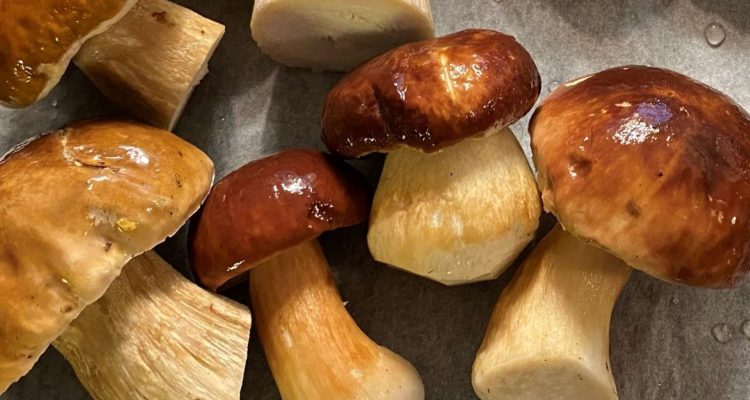
A good read.